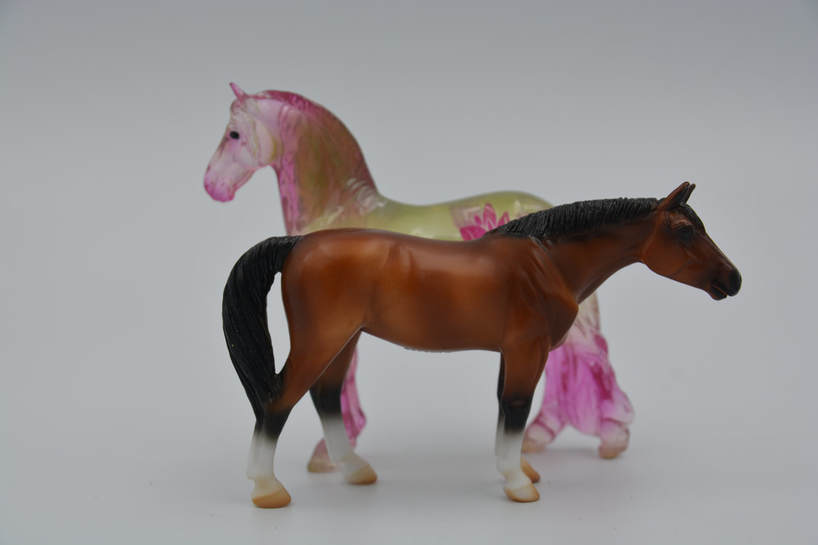Our Breyer size guide will talk you through the various different sizes of Breyer model horses with lots of images to help you understand the different sizes and difference.
If you would like to request a specific comparison picture please email [email protected]
For a more in depth discussion of model horse scales please click here
If you would like to request a specific comparison picture please email [email protected]
For a more in depth discussion of model horse scales please click here
The Sizes
There are five basic Breyer scales:
Traditional (1:9)
Classic (1:12)
Paddock Pal/Littlebit (1:24)
Stablemate (1:32)
Mini Whinnie (1:64)
The approximate scales given are not massively accurate for Breyer horses, for example Paddock Pals are closer to 1:18 scale than 1:24.
The image below shows these five scales, from back to front:
Traditional
Classic
Paddock Pal
Stablemate
Mini Whinnie
Traditional (1:9)
Classic (1:12)
Paddock Pal/Littlebit (1:24)
Stablemate (1:32)
Mini Whinnie (1:64)
The approximate scales given are not massively accurate for Breyer horses, for example Paddock Pals are closer to 1:18 scale than 1:24.
The image below shows these five scales, from back to front:
Traditional
Classic
Paddock Pal
Stablemate
Mini Whinnie
Traditional
With the exception of the 1:6 scale foals Traditional is the largest scale that Breyer produce. These models are sold as around 1:9 scale.
The image below shows a comparison between a heavy horse, light horse and pony. From back to front:
Heavy Horse
Light Horse
Pony
The image below shows a comparison between a heavy horse, light horse and pony. From back to front:
Heavy Horse
Light Horse
Pony
Just like with the adult horses there is also a size difference with the foals. The below image shows a comparison between heavy, light and pony foals.
From back to front:
Heavy Foal
Light Foal
Pony Foal
From back to front:
Heavy Foal
Light Foal
Pony Foal
Here we can see a comparison between a Traditional scale heavy horse and heavy horse foal. The Clydesdale Mare and Foal are produced to go together so make a good comparison.
From back to front:
Heavy Horse
Heavy Horse Foal
From back to front:
Heavy Horse
Heavy Horse Foal
The same height comparison can be seen between traditional scale light horses and foals. Here we see Smart Chic Olena with the Stock Horse Foal.
From back to front:
Light Horse
Light Horse Foal
From back to front:
Light Horse
Light Horse Foal
Finally we have a Traditional scale pony and foal. Again this is a set that is made to go together, Misty and Stormy.
From back to front:
Pony
Pony Foal
From back to front:
Pony
Pony Foal
Classic
Classic is the second largest scale that Breyer produce. They are marketed as around 1:12 scale. As we get smaller the Breyer scales and models become a little more variable. Classic horses have varied greatly in size over the years with newer models being much larger than older ones.
Here we can see evidence of this with a comparison between a heavy horse mould and a light horse mould.
From back to front:
Light Horse
Heavy Horse
Here we can see evidence of this with a comparison between a heavy horse mould and a light horse mould.
From back to front:
Light Horse
Heavy Horse
The below image shows the extreme size difference between old and new Classic moulds. The older moulds tend to be much smaller than the new ones.
From back to front:
New Style Breyer Classic
Old Style Breyer Classic
From back to front:
New Style Breyer Classic
Old Style Breyer Classic
This difference can also be seen when we compare adult and foal moulds. Here you can see the newer style Show Thoroughbred as compared to the Quarter Horse Foal (which is much smaller in scale).
From back to front:
Light Horse
Light Horse Foal
From back to front:
Light Horse
Light Horse Foal
Paddock Pal
There are a very small number of Paddock Pal (also referred to as Littlebit) moulds. Most of these are light horses but there is one drafter so we have included a size comparison between them.
From back to front:
Light Horse
Heavy Horse
From back to front:
Light Horse
Heavy Horse
Stablemate
There is less of a pronounced height difference between Stablemate models, however, some new ones have been very different in scale to the older models. There is also a definite difference between the ponies and light horse moulds.
From back to front:
Heavy Horse
Light Horse
Pony
Foal
From back to front:
Heavy Horse
Light Horse
Pony
Foal
As mentioned above some of the newer moulds are very different in size to the older ones. Django is a prime example of this. Here we can see a comparison between the new Django mould and another reasonably new mould the G4 Paradressage.
It is worth noting that some newer moulds such as Esperanza are actually much smaller!
From back to front:
G4 Django
G4 Paradressage
It is worth noting that some newer moulds such as Esperanza are actually much smaller!
From back to front:
G4 Django
G4 Paradressage
Mini Whinnies
There is very little difference in height between the different Mini Whinnie moulds. The drafters are about the same size as the light horses.
From left to right:
Heavy Horse
Light Horse
From left to right:
Heavy Horse
Light Horse
There is a sensible height difference however between the adults and the foals. Although as with the adults the heavy horse foals and light horse foals are about the same height.
From back to front:
Light Horse
Foal
From back to front:
Light Horse
Foal














